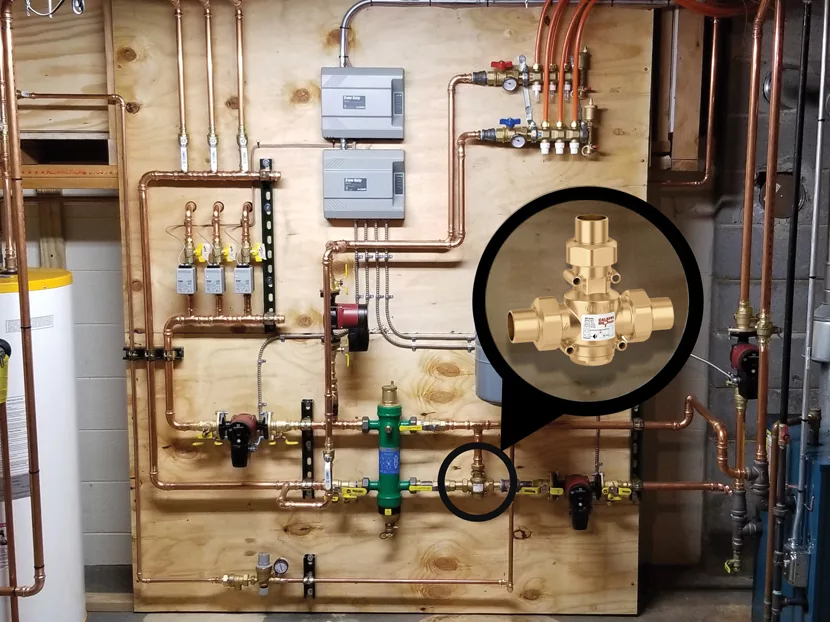Being a wholesale distributor can be tough! Contractors need the right products, at a reasonable cost and often with a short lead time. They also might want their wholesaler to know highly intricate technical details of product and system design. In today’s rapidly changing hydronics market, outstanding technical product knowledge often separates the finest wholesalers from the rest of the pack. It develops the type of loyalty that keeps contractors coming back for years to come.
Some wholesalers take this philosophy to the next level. Once, during my many travels as a technical trainer (back before COVID-19, when traveling was acceptable and even encouraged), I ran across just this type of wholesaler. I had arrived on site, excited to conduct training for the firm’s sales team on a new product. Its dedication to product training already put the distributor ahead of the game.
What impressed me even more was walking by the owner’s office and overhearing him in an incredibly detailed conversation about how to wire and set up third-party boiler controls. This was the owner’s office. I was in awe.
The company is a very successful single-branch wholesaler. A superior technical understanding of the products they sell permeates the organization. They can support their contractors as I’d never seen before.
So, with that spirit in mind, here are some hydronic tips and tricks with a high probability of helping you sell more product and keep your customers coming back for more.
Tip No. 1: Use a Mixing Valve
Let’s consider multiple temperatures in a hydronic system. Different types and sizes of heat emitters may dictate varying supply water temperatures. For instance, copper fin-tube baseboard emitters may require 180 F to heat the home on a design day, but that new addition with in-floor heating will likely only need 130 F at a maximum.
So, when you’re pricing out the oxygen barrier PEX (yes, they need oxygen barrier tubing for heating systems), manifolds and other items for your customer, he’s also going to need a mixing valve. The boiler will have to run at that higher 180 F temperature to satisfy the baseboard; the mixing valve will allow you to run a lower temperature to accommodate the in-floor radiant.
Remember, if you’re adding a mixing valve to create a different supply water temperature, you need a circulator for that different temperature as well. The circulator used for the high temperature cannot be used for the low temperature. Also, when piping the low-temperature zone, you’ll always pump away from the mixing valve, not into the hot inlet. It causes similar pressures in the mixing valve’s hot and cold inlets, which is required for a properly functioning mixing valve.
Tip No. 2: Boiler Harmony
Same song as the first, just a different verse. If your customer is creating multiple temperatures in a hydronic system, make sure the boiler is OK with it. High-efficiency condensing boilers thrive on low return water temperatures to get an extra bit of efficiency. Standard cast-iron or copper-fin boilers are not designed to consistently function with low return water temperatures. Condensing of the combustion gases in these boilers will lead to their early demise.
A new, high-efficiency boiler would be a great sale, but there are means to make those older-style cast-iron boilers work in these applications as well. Want the boiler as happy as a clam? Ultimately, what is needed is to bring the return water temperatures up above the magic 130 F mark.
This is best accomplished by using boiler protection valves. They come in various forms, such as three-way, four-way, thermostatic or electronic. If you’re feeling feisty, you can even look into injection mixing. It maintains your supply water temperature to the low-temperature zone and can maintain minimum return water temperatures as well with the proper controls.
Tip No. 3: Don’t Oversize
This tip applies to any circulated system, whether it be a domestic hot water recirculation or hydronic system. If a customer believes that replacing pin-holed copper pipe sections is normal, suggest that they think again. It may be an excellent means of job security, but I can guarantee that no system was ever designed to torpedo itself in such a fashion.
Ventilated copper pipe is caused by excess fluid velocity. This can be a consequence of too-small piping, but it is more commonly due to the oversizing of circulators. Usually, you will see this phenomenon directly after an elbow. In addition to the turbulence caused by the change in direction, the excess velocity offers an education on how much water it takes to redecorate the floors with soggy ceiling tiles.
So, if you run into this at the counter, you’ll know what advice to give. You may want to put that contractor in touch with one of your tech guys or a pump rep who is willing to lend a hand.
Tip No. 4: Pay Attention to the Water
If you have bad water in your area, you probably know it. Whether it’s your bustling water softener sales or the fact that you know replacement mixing-valve cartridge part numbers by heart, you understand that the water quality leaves a bit to be desired. This water that wreaks so much havoc in potable systems is likely what contractors are using to fill hydronic systems.
Not all potable water should go into hydronic systems. Boiler manufacturers have become increasingly strict regarding the quality of water being run through their equipment. As much as they are reluctant to warranty boiler heat exchangers, they don’t want to warranty one that is damaged by no fault of their own.
So, you might believe that the entire problem will be solved by softening the water. It will not. Removing the magnesium and calcium will solve scaling issues, but it won’t prevent galvanic corrosion. During the water softening process, the magnesium and calcium are replaced with sodium; dissolved solids like these create conductivity.
While galvanic corrosion is more common in potable water systems (dielectric union, anyone?), it can still be a problem in hydronic systems. So, what do we do? Boiler chemical companies will be happy to sell products for every boiler system, but once the contractor starts down that road, there’s no turning back. The maintenance of those chemicals will haunt service technicians forever.
Another choice is demineralized water. Demineralization is an ion-exchange process similar to water softening but it will remove all dissolved solids, eliminating the potential for scaling and galvanic corrosion. Demineralized water is easier than ever to achieve due to portable units that allow site water to be turned into the perfect heat transfer medium. If the job warrants, you can usually buy demineralized water in bulk from a water treatment company as well.
I hope you found these tips helpful. Contractors often express a common view that the wholesalers they like best never stop learning. The more knowledge and experience they gain, the more valuable they become as the go-to hydronics wholesaler.





